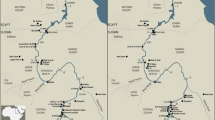Abstract
The 19th century hivernant Metis of the northwestern Canadian plains and parklands followed a way of life centered on communal bison hunting and frequent mobility. Contrary to what might be expected, excavations at five hivernant wintering sites consistently have recovered a variety of fragile, transfer printed, earthenware ceramics. In this context, ceramics, as a form of material culture, are seen to incorporate an ambiguity in function and meaning. In exploring this ambiguity, it is suggested that Metis ceramic use originates with an initial concern for female status and etiquette in Red River fur trade society. Ultimately, ceramics are argued to have assumed a much greater symbolic role. This role was integral in hivernant Metis social interaction and integration.
Similar content being viewed by others
References
Anick, Norman 1976 The Metis of the South Saskatchewan River. Manuscript Report 364, 2 vol., Parks Canada, Ottawa.
Anonymous 1860 To Red River and Beyond. Harpers New Monthly Magazine 1860(August):584–585.
Brown, Jennifer 1980 Strangers in Blood, Fur Trade Company Families in Indian Country. University of British Columbia Press, Vancouver.
Burley, David, Gayle Horsfall and John Brandon 1988 Stability and Change in Western Canadian Metis Lifeways: An Archaeological and Architectural Study. Ms. on file Archaeological Resource Management Section, Saskatchewan Department of Culture and Recreation, Regina.
Doll, Maurice F. V. 1983 The Buffalo Lake Metis Site (FdPe 1): Report on Project 82–27 Field Season of 1982. Ms. on file, Archaeological Survey of Alberta, Edmonton.
Doll, Maurice F. V., and Robert Kidd 1976 The Buffalo Lake Metis Site. Ms. on file, Provincial Museum of Alberta, Edmonton.
Douglas, Mary, and Baron Isherwood 1979 The World of Goods: Towards an Anthropology of Consumption. Allen Lane, London.
Elliott, Jack 1971 Hivernant Archaeology in the Cypress Hills. Unpublished M.A. Thesis, University of Calgary, Calgary.
1972 Tobacco Pipes Among the Hivernant Hide Hunters: A.D. 1860–1870. The Western Canadian Journal of Anthropology 3(1): 146–57.
Foster, John E. 1976 The Origins of the Mixed Bloods in the Canadian West. In Essays on Western History, edited by L. H. Thomas, pp. 69–80. University of Alberta Press, Edmonton.
1985 Some Questions and Perspectives on the Origins of Metis Roots. In The New Peoples: Being and Becoming Metis in North America, edited by J. Peterson and J. Brown, pp. 73–91. The University of Manitoba Press, Winnipeg.
Giraud, Marcel 1986 The Metis in the Canadian West, translated by G. Woodcock, 2 vol. University of Alberta Press, Edmonton (original French edition published 1945).
Leone, Mark P. 1982 Some Opinions About Recovering Mind. American Antiquity 47(4):742–60.
Peterson, Jacqueline 1981 The People in Between: Indian-White Marriages and the Genesis of a Metis Society and Culture in the Great Lakes Region, 1680–1830. Unpublished Ph.D. Dissertation, University of Illinois at Chicago Circle, Chicago.
Pyszczyk, Heinz W. 1985 The Role of Material Culture in the Structure of Fur Trade Society. In Status, Structure and Stratification: Current Archaeological Reconstructions, edited by M. Thompson, M. T. Garcia and F. Kense, pp. 399–406. The Archaeological Association of the University of Calgary, Calgary.
Ray, Arthur J. 1974 Indians in the Fur Trade: Their Role as Hunters, Trappers and Middlemen in the Lands Southwest of Hudson Bay 1660–1870. University of Toronto Press, Toronto.
Robinson, H. M. 1879 The Great Fur Land or Sketches of Life in the Hudson’s Bay Territory. G. P. Putnam’s Sons, Ltd., New York.
Roe, Frank G. 1934 The Extermination of the Buffalo in Western Canada. The Canadian Historical Review 15(1): 1–23.
Ross, Alexander 1957 The Red River Settlement: Its Rise Progress and Present State. Ross and Haines Inc., Minneapolis (original published 1856).
Sprague, D. N., and R. P. Frye 1983 The Genealogy of the First Metis Nation: The Development and Dispersal of the Red River Metis, 1820–1900. Pemmican Publications, Winnipeg.
Sussman, Lynne 1979 Spode/Copeland Transfer-Printed Patterns. Parks Canada Occasional Papers in History and Archaeology, 23, Ottawa.
Van Kirk, Sylvia 1980 Many Tender Ties: Women in Fur Trade Society, 1670–1870. Watson and Dwyer, Winnipeg.
Author information
Authors and Affiliations
Rights and permissions
About this article
Cite this article
Burley, D.V. Function, meaning and context: Ambiguities in ceramic use by the hivernant Metis of the northwestern plains. Hist Arch 23, 97–106 (1989). https://doi.org/10.1007/BF03374101
Published:
Issue Date:
DOI: https://doi.org/10.1007/BF03374101




